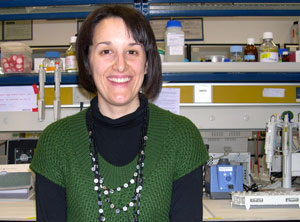| Posted: May 18, 2009 |
Nanoparticles to be used in genic therapy |
|
(Nanowerk News) Genic therapy can be used both with rare diseases, such as cystic fibrosis and disorders of the retina, as well as with more common illnesses, such as AIDS, cancer and neurodegenerative diseases (for example, Parkinson’s or Alzheimer’s).
|
|
The author of the PhD is Ms Ana del Pozo Rodríguez (Vitoria, 1980), a pharmacy graduate, who defended her thesis entitled, Development of solid lipid nanoparticles as systems for and administration in genic therapy. The directors of the PhD were Ms Alicia Rodríguez Gascón and Ms María Ángeles Solinís Aspiazu from the Department of Pharmacy and Food Sciences at the Pharmacy Faculty of the University of the Basque Country (UPV/EHU).
|
 |
| Ana del Pozo Rodríguez, the PhD thesis author.
|
|
In undertaking the research, the author of the thesis worked with the Ernest Giralt team at the Institut de Reserca Biomèdica in Barcelona (IRB Barcelona). Ms del Pozo Rodríguez is currently working as a researcher for CIBER-BNN at the Pharmacy and Pharmaceutical Technological Laboratory at the Pharmacy Faculty of the UPV/EHU.
|
|
Administration of genes
|
|
Ms del Pozo’s thesis describes the development, characterisation and optimisation of a system of administration of genes based on solid lipid nanoparticles (SLNs). These particles, more or less the size of one micron and with a positive surface charge, are capable of transporting genes to the interior of the cells and enable the transport of nucleic acids — ADN or ARN — in order to be used in genic therapy. These therapies can be employed as a therapeutic tool to cure illnesses that currently only have a palliative treatment of symptoms.
|
|
The researcher studied factors related to the composition of nanoparticles that affect the capacity of transporting genes to different cells, investigating the behaviour of the particles within the cells through various microscopic techniques.
|
|
|
|
Optimisation with a peptide
|
|
In order to optimise the functioning of SLNs, these were combined with a peptide that enhances the entry of the genes into the cells — peptides are organic compounds that are found in most living tissues, and they have multiples biological functions. It is this part of the work that is being undertaken in collaboration with the IRB Group from Barcelona.
|
|
Work has also been carried out in order to improve the stability of the nanoparticles and, finally the capacity of the SNLs for transporting the genes evaluated. To this end, both in vitro and in vivo trials were undertaken — the latter through intravenous administration in mice.
|
|
Without effects for immunity
|
|
Therapies based on transporting genes to the interior of cells – using viruses – already exist. This technique is based on the natural capacity of viruses to penetrate the nucleus of a cell and so take the DNA or RNA there; however, the method can affect immunity. This is why it is necessary to develop particles with the same capacity for penetrating cells but without the side-effects on cell immunity.
|

